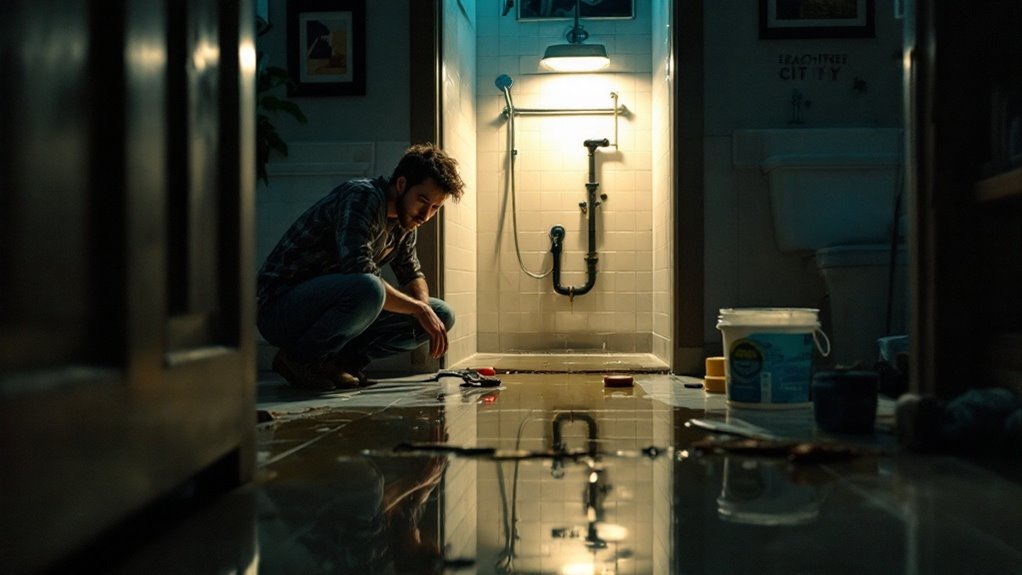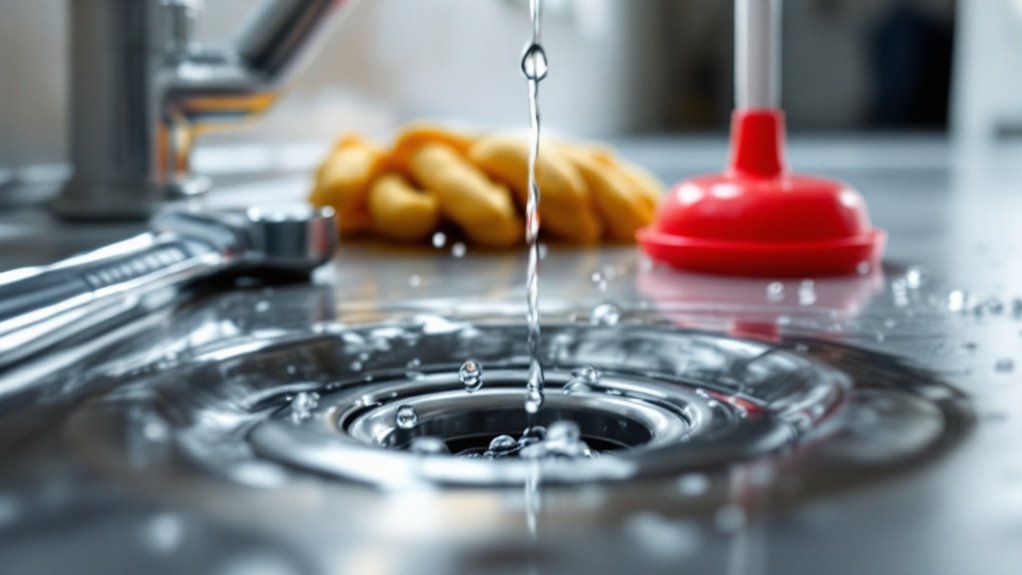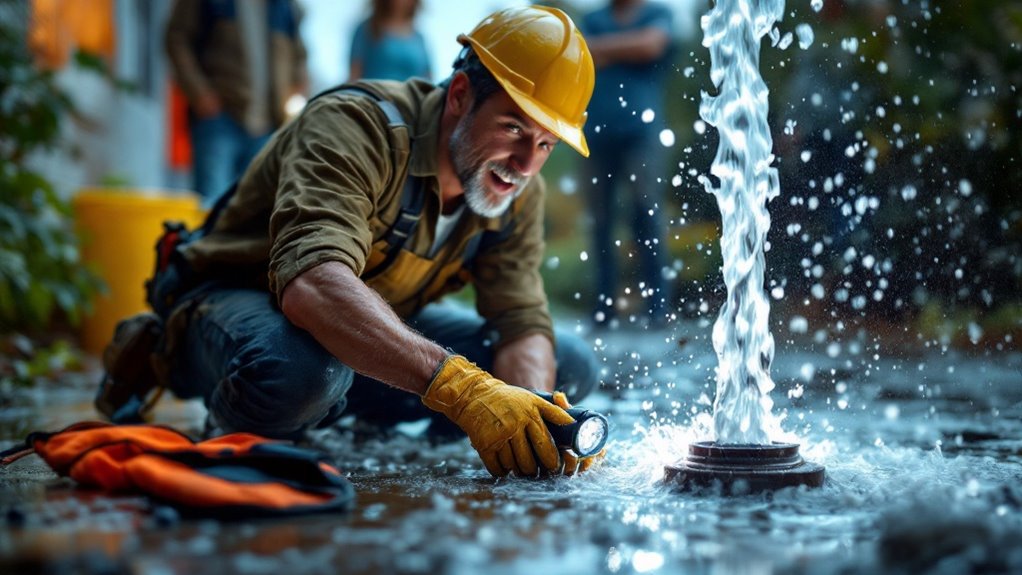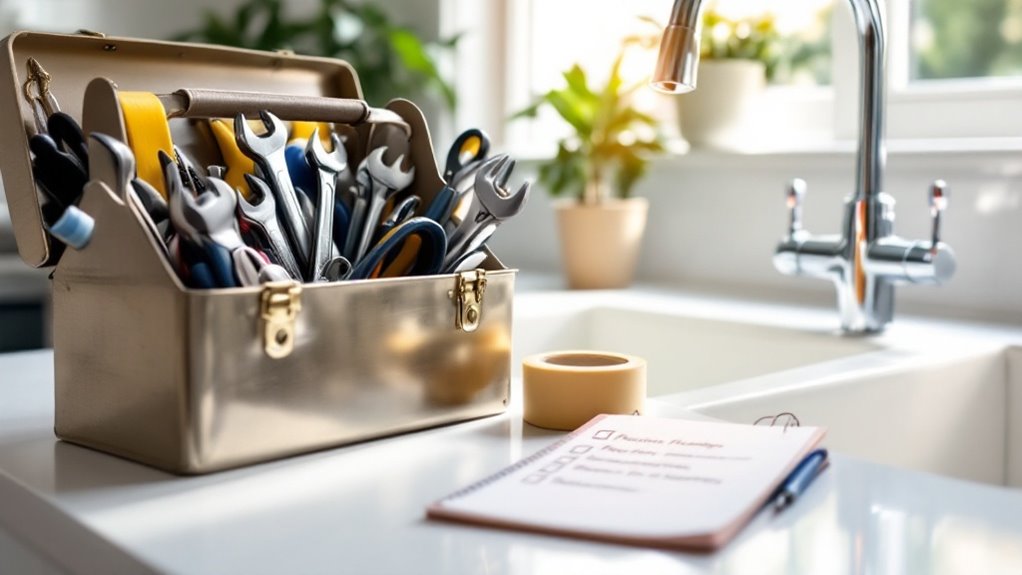When a plumbing emergency strikes in Peachtree City, first shut off the main water supply to prevent further damage. Assess the problem by identifying leaks or clogs and document everything for reference. Implement temporary fixes, like using a plunger or waterproof tape on minor leaks. Stay safe by cutting power to affected appliances and avoiding further use of plumbing fixtures. If issues persist or worsen, call a professional plumber immediately. Learn more about effective solutions and preventative measures.
Key Takeaways
- Identify the source of the plumbing emergency by checking for leaks, water stains, or unusual water pressure changes.
- Turn off the main water valve immediately to prevent further damage to your property.
- Use temporary fixes like waterproof tape for minor leaks or a plunger for clogged toilets until professional help arrives.
- Document the issue thoroughly for the plumber's reference and to track the problem's progression.
- Contact a local emergency plumbing service in Peachtree City for professional assistance and resolution of the issue.
Recognizing the Signs of a Plumbing Emergency

How can you tell if you're facing a plumbing emergency? Recognizing emergency signs early can save you from extensive damage. If you notice plumbing symptoms like sudden water pooling, unusual water pressure changes, or persistent foul odors, you might be in trouble. Furthermore, keep an eye out for gurgling drains or toilets that refuse to flush properly. These issues often indicate blockages or leaks that require immediate attention. If water starts seeping through walls or ceilings, don't ignore it; that's a clear signal of a serious problem. Staying aware of these signs guarantees you can act quickly, preserving your home's integrity and preventing costly repairs. Remember, addressing plumbing issues promptly can make all the difference. Additionally, it's crucial to contact a 24/7 emergency hotline when you suspect a plumbing crisis to ensure swift assistance.
Shutting Off the Water Supply
In a plumbing emergency, your first step is to locate the main water valve, which is usually found near the perimeter of your home. Once you find it, turn off the valve to stop the flow of water. Furthermore, it's essential to turn off any appliances connected to the water supply to prevent further damage. Additionally, contacting an emergency plumbing service can provide immediate assistance and prevent extensive damage to your property.
Locate Main Water Valve
When a plumbing emergency strikes, locating the main water valve is crucial for shutting off the water supply quickly. Typically, you'll find the main valve location near where the water line enters your home, often in the basement, crawl space, or outside near the foundation. To identify it, look for a round or rectangular-shaped valve with a handle. It may be made of brass or plastic. Valve identification tips include feeling for cold pipes, which often indicate cold water supply lines. If you're unsure, follow the water line from your meter or consult your home's plumbing diagram. Remember, acting swiftly can minimize damage and save you from costly repairs.
Turn Off Appliances
As you manage a plumbing emergency, it's vital to turn off appliances connected to the water supply to prevent further damage. Begin by cutting power to your washing machine, dishwasher, and any other water-using appliances. This step not only protects your devices but additionally promotes appliance safety by minimizing electrical hazards. If possible, unplug them to guarantee no residual power remains. Next, locate the shut-off valves for these appliances—most are easily accessible behind or beneath the units. Turn off these valves to halt water flow. By taking these swift actions, you'll greatly reduce the risk of leaks or floods, allowing you to focus on resolving the plumbing issue at hand without added stress.
Assessing the Problem

To effectively assess the plumbing issue, start by identifying the leak source to understand where the problem lies. Next, check the water pressure to gauge the severity of the situation. Finally, determine the urgency level to prioritize your response accordingly.
Identify the Leak Source
How can you effectively identify the source of a plumbing leak? First, conduct a thorough moisture assessment in your home. Look for water stains, damp spots, or mold growth, as these are indicators of potential leaks. Utilize leak detection methods such as listening for dripping sounds or checking your water meter for unexpected usage.
| Indicators | Actions |
|---|---|
| Water stains | Inspect ceiling and walls |
| Damp spots | Use a moisture meter |
| Mold growth | Check hidden areas |
| Dripping sounds | Listen near pipes |
| Water meter readings | Compare daily usage |
Check Water Pressure
Checking water pressure is vital for diagnosing plumbing issues effectively. Start by using a pressure gauge, which you can attach to an outdoor spigot or your main line. Once connected, turn on the water and observe the reading. Normal residential water pressure typically ranges from 40 to 60 psi. If you notice markedly lower pressure, it may indicate a blockage or leak in your system, affecting water flow. Conversely, excessively high pressure can lead to pipe damage and leaks. In either case, understanding your water pressure helps pinpoint the problem, allowing for a more targeted solution. Remember, accurate measurements are critical for maintaining your plumbing's health and ensuring a smooth flow throughout your home.
Determine Urgency Level
Evaluating the urgency level of a plumbing issue is crucial for effective response. An accurate urgency assessment helps you prioritize actions and prevent further damage. Here's how to categorize the situation:
- Immediate Threat: Water flooding your home or sewage backup requires urgent intervention.
- Significant Risk: A leaking pipe that could cause structural damage needs prompt attention but may allow short-term measures.
- Minor Concern: Dripping faucets or slow drains can wait for a scheduled repair.
Implementing Temporary Fixes
When faced with a plumbing emergency, implementing temporary fixes can help mitigate damage until a professional arrives. Start by identifying the source of the leak or blockage. For minor leaks, using waterproof tape or a rubber patch can serve as effective temporary solutions. If it's a pipe burst, turning off the water supply and wrapping the affected area with towels can minimize water damage. For overflowing toilets, you can use a plunger to manage the situation temporarily. Keep in mind that DIY repairs are just that—temporary. Document the issue for your plumber, as this information will assist in a permanent fix. Remember, these temporary measures allow you to regain control until experts can address the problem properly.
Dealing With Clogged Drains

As you encounter a clogged drain, it's crucial to act swiftly to prevent further complications. Clogged sinks can lead to serious issues if not addressed promptly. Here's what you can do:
- Use a Plunger: A sturdy plunger can create the necessary suction to dislodge blockages.
- Try Drain Cleaning Solutions: Commercial drain cleaners or natural options like baking soda and vinegar can break down debris.
- Check the Trap: If the blockage persists, remove and clean the trap under the sink to eliminate buildup.
Handling Leaks and Burst Pipes
How can you quickly address leaks and burst pipes before they cause extensive damage? First, locate the source using effective leak detection methods, like visual inspections or moisture meters. Once identified, shut off the water supply to prevent further flooding. If it's a burst pipe, apply temporary pipe insulation around the damaged area to minimize water loss until a professional arrives. Keep an eye out for signs of water damage, such as discoloration on walls or ceilings. To prevent future issues, consider investing in high-quality pipe insulation to protect against temperature fluctuations. By taking these immediate steps, you can mitigate damage and guarantee your plumbing system stays functional and reliable.
The Importance of Safety Precautions

While addressing plumbing emergencies, prioritizing safety precautions is crucial to protect both yourself and your property. You should always make sure you're prepared. Here are three fundamental safety measures to follow:
- Wear Appropriate Safety Gear: Use gloves and goggles to shield yourself from hazardous materials and sharp objects.
- Prepare an Emergency Kit: Keep a kit stocked with important tools, towels, and a flashlight. This guarantees you can quickly address minor issues or contain leaks before they escalate.
- Turn Off Water Supply: If you encounter a leak or burst pipe, immediately shut off the main water supply to prevent further damage.
When to Call a Professional Plumber
Recognizing when to call a professional plumber can save you time and prevent costly damage. If you're facing severe leaks, constant clogs, or water pressure issues, it's essential to seek emergency plumbing services immediately. Don't ignore signs like discolored water or unusual sounds from pipes—these often indicate deeper problems. If your DIY attempts haven't solved the issue, or if you feel overwhelmed, it's time to reach out for help. Professional services guarantee that the job is done right, minimizing the risk of future emergencies. Remember, plumbing systems are complex, and a small oversight can lead to significant damage. Trusting a qualified plumber means you'll have peace of mind and a resolution tailored to your specific needs.
Preventative Measures for the Future

Taking proactive steps can considerably reduce the likelihood of plumbing emergencies in the future. By implementing regular maintenance and scheduling plumbing inspections, you can catch potential issues before they escalate. Here are three crucial measures to contemplate:
- Schedule Regular Maintenance: Routine checks of your plumbing system guarantee that all components function correctly and efficiently.
- Conduct Plumbing Inspections: Have a professional inspect your pipes and fixtures at least once a year to identify any hidden problems.
- Monitor Water Pressure: High water pressure can stress your plumbing, leading to leaks. Use a pressure gauge to keep it in check.
Frequently Asked Questions
How Can I Find a Reliable Plumber in Peachtree City?
To find a reliable plumber, check online plumber reviews, focusing on feedback about service guarantees. Ask friends for recommendations too; personal experiences often lead you to trustworthy professionals who prioritize quality and customer satisfaction.
What Should I Do if My Toilet Overflows?
When your toilet overflows, panic can set in. First, shut off the water supply. Then, identify the causes—clogs or faulty parts. Follow emergency plumbing tips to prevent damage and restore order quickly.
Are There Emergency Plumbing Services Available 24/7 in Peachtree City?
Yes, you'll find several emergency plumbing services with 24/7 availability in Peachtree City. Their quick emergency response guarantees that you get help promptly, minimizing damage and restoring your peace of mind when issues arise.
How Can I Prevent Future Plumbing Emergencies?
To prevent future plumbing emergencies, nurture your system like a garden. Regularly schedule drain maintenance and pipe inspections, ensuring everything flows smoothly. This proactive care cultivates peace of mind and protects your home from unexpected troubles.
What Local Regulations Should I Be Aware of for Plumbing Repairs?
When tackling plumbing repairs, you've gotta check local permits and plumbing codes. Compliance guarantees safety and avoids fines. Familiarize yourself with these regulations, so you can confidently manage your plumbing projects without any unexpected setbacks.
